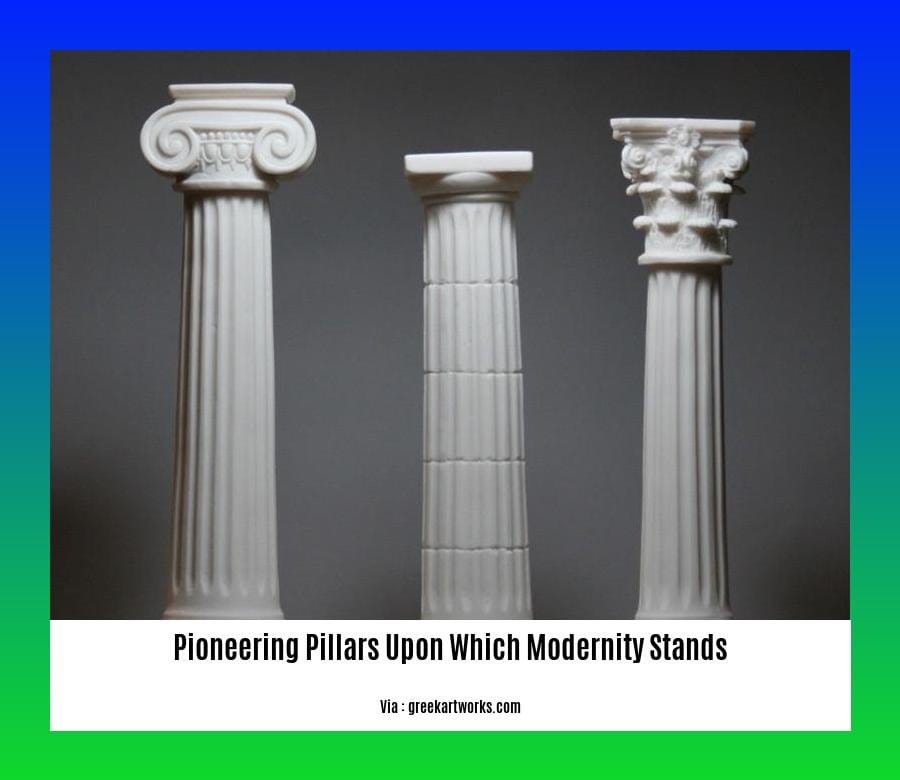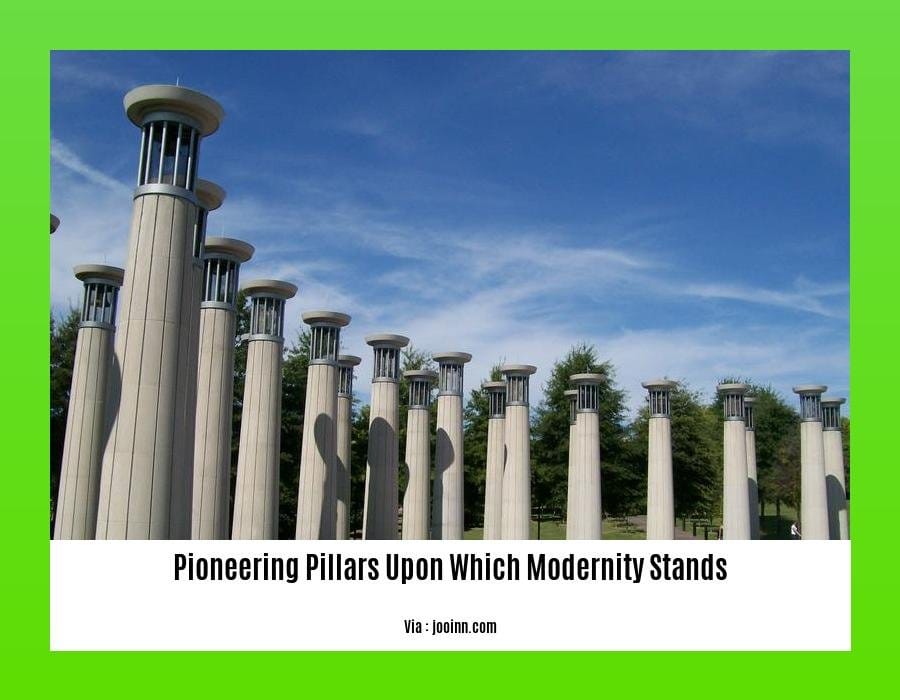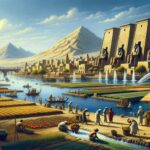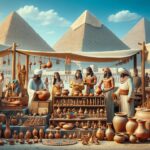In “The Pioneering Pillars Upon Which Modernity Stands,” we unveil the fundamental pillars that ignited the Enlightenment and subsequent revolutions, shaping the very fabric of our contemporary world. Through a meticulous examination of intellectual, scientific, technological, and artistic advancements, this article delves into the genesis and evolution of modernity, illuminating the profound impact these pioneering ideas have had on the human story.
Key Takeaways:

- Idea of Progress: Modernity is characterized by a belief in progress and the perfectibility of society.
- Rejection of Tradition: Tradition and religious authority are challenged in modernity, leading to new ideas and social structures.
- Emphasis on the Individual: Individualism and self-expression become central values in modern societies.
- Expansion of Knowledge: Scientific inquiry and the spread of knowledge contribute to the transformation of society.
- New Social Structures: Modernization leads to new social classes, occupations, and power dynamics.
The Pioneering Pillars Upon Which Modernity Stands
Modernity emerged from a revolutionary shift in human thought and society, leaving lasting impacts on our contemporary world. This groundbreaking transformation was anchored upon several pioneering pillars, each contributing to the distinctive features of the modern era:
Ideological Totalization
Modernity is characterized by an overarching societal belief system that replaced traditional religious systems. Society as a whole becomes sacred, imbued with a sense of ultimate purpose and value.
Moral Reenchantment
In contrast to the disenchantment often associated with modernity, a moral reenchantment took place. Modernity creates new sources of meaning and sanctity, endowing social institutions with a profound sense of purpose.
Epistemic Rift
Modernity witnessed a profound disruption in social knowledge systems, with elites and the populace questioning and challenging traditional ways of knowing. This epistemic rupture allowed for new ideas and knowledge to emerge.
Memetic Replication
Modernity’s cultural forms became replicable templates, spreading modern norms and practices. These cultural forms, similar to memes in today’s digital age, contributed to the dissemination of modern ideas and behaviors.
Social Subjectification
Modernity invented the modern subject through manners, discipline, and knowledge. Individuals gained a heightened sense of agency and self-awareness, fostering the development of autonomous, introspective citizens.
These pioneering pillars laid the foundation for the modern world, profoundly shaping our intellectual, social, and cultural landscapes. They continue to influence our understanding of society and its trajectory, providing insights into the origins and evolution of our contemporary world.
Explore the pioneers who laid foundations of modern civilization, whose groundbreaking discoveries and innovations shaped the world we live in today. Delve into the lives of the forefathers whose innovations shaped modern world, and uncover the civilization’s pioneering building blocks that have stood the test of time.
Artistic and Literary Flourishing
Immersion in the arts and humanities enriches our lives, fostering well-being, self-expression, and creativity. Like a symphony that sweeps us away, arts have the power to detach us from our daily worries, immersing us in a realm of sensory and emotional experiences.
Art and literature can inspire profound transformations, encouraging growth, reconciliation, and solace. They challenge norms, spark dialogue, and ignite social change. Think of the powerful impact of literature on social justice movements or the way art can bridge cultural divides.
Modernism, with its emphasis on Surrealism, Cubism, and the abstraction of artists like Mondrian and Kandinsky, revolutionized Artistic and Literary Flourishing. It challenged traditional forms, embraced experimentation, and encouraged a deeper exploration of the inner psyche.
Key Takeaways:
- Arts and humanities enhance human flourishing.
- Arts evoke sensory and emotional experiences, freeing us from daily worries.
- Arts and humanities inspire growth, promote reconciliation, and provide solace.
- Modernism significantly influenced Artistic and Literary Flourishing.
Citation: Art and the flourishing life
Emergence of Nation-States and Capitalism
From the ashes of feudal Europe, a new order arose: nation-states. These sovereign entities, with their unified territories and populations, became the building blocks of our modern world. Their emergence was driven by a perfect storm of nationalism, industrialization, and modernization.
Industrial Revolution
The Industrial Revolution demanded standardization and regulation, which could only be provided by centralized authorities. Nation-states stepped into this vacuum, creating the necessary framework for economic growth.
Challenges
The path to nationhood was not without its obstacles. Ethnic diversity, imperialism, and wars threatened to tear these nascent states apart. But the idea of a unified people, bound by shared history and culture, proved resilient.
Capitalism
In the shadow of nation-states, another transformative force emerged: capitalism. This economic system, based on private ownership and profit-making, unleashed an unprecedented wave of innovation and prosperity. Capitalism’s relentless pursuit of growth and accumulation became the driving force of the modern world.
Key Takeaways:
- Nation-states emerged from feudal Europe, characterized by unified territory, population, and government.
- Nationalism, industrialization, and modernization played key roles in their formation.
- Capitalism, with its emphasis on private ownership and profit, fueled economic growth and innovation.
Citation:
Global Interconnections and Cultural Exchange
Key Takeaways:
- History unravels through the lens of global interconnections, shaping civilizations.
- Cultural exchange has fostered vibrant societies, blending traditions and perspectives.
- Global value chains highlight our interconnectedness and interdependence.
- The colonial encounter ignited cognitive shifts, reshaping worldviews.
- Cultural globalization standardizes experiences, spreading commodities and ideas worldwide.
Tracing the Threads of Interconnection
From ancient trade routes to modern-day migrations, global interconnections have woven a tapestry of human interaction. Empires like the Roman and Mongol connected diverse regions, fostering cultural exchanges and the spread of ideas. The Silk Road, linking East and West, exemplified this vibrant exchange, where goods, knowledge, and religions intermingled.
The Crucible of Cultural Exchange
Cultural exchange has been a catalyst for innovation and growth throughout history. Artistic influences, technological advancements, and philosophical concepts have crossed borders, enriching societies. For example, the Renaissance in Europe was partly inspired by the rediscovery of classical Greek and Roman texts, while Islamic scholarship made significant contributions to mathematics, astronomy, and medicine.
The Interdependence of Our World
Global value chains reveal the intricate web of interdependence that connects economies and cultures. Raw materials from one corner of the world are transformed into finished products in another, highlighting the interconnectedness of production and consumption. This interdependence has also led to increased collaboration and cooperation on global issues such as climate change and poverty reduction.
The Shadow of the Colonial Encounter
The colonial encounter played a profound role in shaping global interconnections and cultural exchange. European colonialism imposed its own values and institutions on indigenous societies, leading to both cultural assimilation and resistance. The legacy of colonialism continues to influence power dynamics and cultural interactions today.
Globalization: A Double-Edged Sword
Cultural globalization has both homogenized and diversified our world. The spread of Western media, consumer goods, and lifestyles has standardized certain aspects of daily life. Yet, it has also spurred a resurgence of cultural identity and pride, as communities seek to preserve their unique traditions amidst globalized influences.
Most Relevant URL Source:
- Bhambra, G. K. (2007). Multiple modernities or global interconnections: Understanding the world order. In Varieties of modernity, 3-28. Cambridge University Press.













